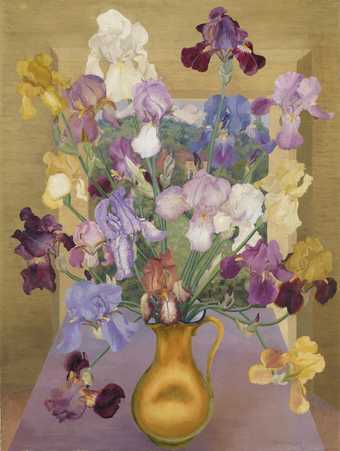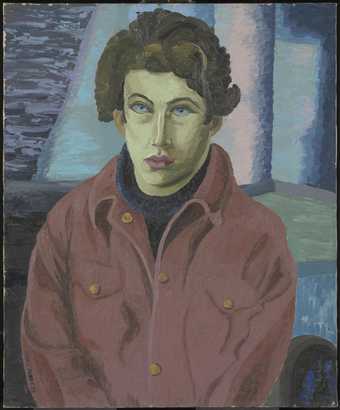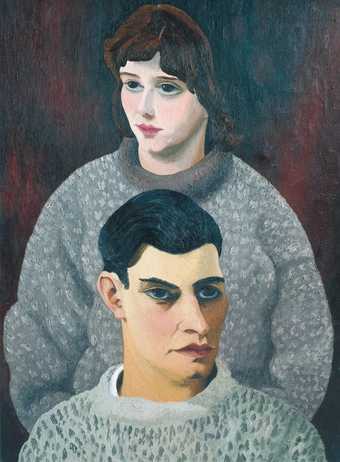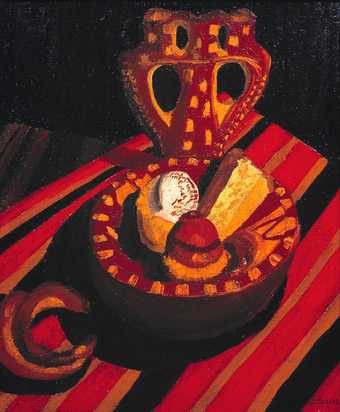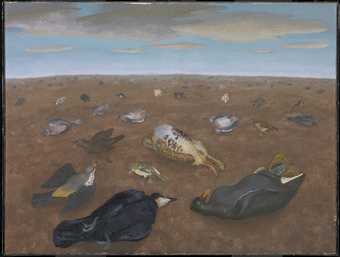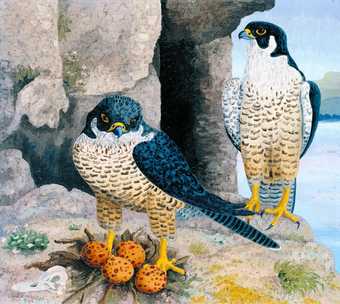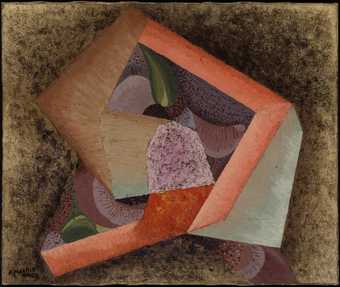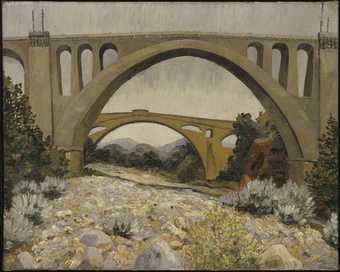
Not on display
- Artist
- Sir Cedric Morris, Bt 1889–1982
- Medium
- Oil paint on canvas
- Dimensions
- Unconfirmed: 615 × 432 mm
- Collection
- Tate
- Acquisition
- Presented by Elizabeth David CBE 1992
- Reference
- T06522
Summary
In 1940 The East Anglian School of Painting and Drawing, founded by Cedric Morris and his partner Arthur Lett-Haines (1894-1978) at Dedham, Essex in 1937, moved to Benton End, a sixteenth century house just outside Hadleigh, Suffolk. There Morris cultivated an extraordinary garden, a large section of which was used to grow fruit and vegetables for the students during the Second World War (1939-45). During this period the garden's produce became a central subject in Morris's paintings, and the result was a body of work celebrating the fecundity of nature at a time marked by general deprivation.
Eggs of various kinds featured in a number of Morris's bird pictures, including Peregrine Falcons 1942 (Tate T05498). They were also the subject of numerous still-lifes. In The Eggs several differently coloured eggs are gathered in a patterned earthenware dish, which is placed on a table or a stool in a simple interior stripped of visual distractions. The flattened perspective of the painting tips the dish up towards the viewer and emphatically presents the eggs as the subject of the painting. The spatial ambiguity and slightly schematic rendering of form reflects Morris's view that 'Realism is not Reality' (quoted in Morphet, p.29). Discussing his flower paintings Morris commented, 'There must always be great understanding between the painter and the thing painted, otherwise there can be no conviction and truth This might be called "vision" and reality, as opposed to realism. Reality is knowledge and realism is only the appearance of knowledge ' (quoted in Morphet, p.87). The composition of The Eggs and the removal of superfluous detail creates what Richard Morphet has described as 'the projection of the subject through a dynamic economy in combination with an acute sense of pictorial relation' (Morphet, p.82).
The intense pinks and yellows of The Eggs also contribute greatly to the 'projection of the subject'. It is as much through the subtle interplay of colours and tones as the careful composition of formal relations that Morris contrived to reflect the inner vitality of his subject matter. The use of such vivid colours was in marked contrast to the subdued earthy palette that characterised so much British painting during the war.
Painted at Benton End, The Eggs was acquired by the cook Elizabeth David around 1953. Her books on Mediterranean food and cooking appeared in the post-war years as lavish publications, signifying the promise of better things and the return of civilised living after the indignities and deprivations of the war. A colour photograph by Richard Dormer of The Eggs accompanied David's article 'The Presentation of Food' which appeared in Harper's Bazaar, March 1955. It was later chosen as the cover for the first edition of Elizabeth David's An Omelette and a Glass of Wine published in 1984.
Further reading:
Richard Morphet, Cedric Morris, exhibition catalogue, Tate Gallery, London 1984, reproduced p.70, cat.no.81 (colour)
Toby Treves
October 2000
Does this text contain inaccurate information or language that you feel we should improve or change? We would like to hear from you.
Display caption
This painting was a gift from the cookery writer Elizabeth David. Her now classic publications of the early 1950s on Mediterranean food and cooking signalled an end to wartime deprivation. In 1940, he moved to the East Anglian School of Painting and Drawing in Suffolk, where he helped alleviate wartime food shortages by growing natural produce for his students. This soon became the dominant subject of his paintings.
Here the eggs are tipped toward the viewer like objects of wonder and fecundity. The picture's bold use of colour was typical of Morris; he encouraged his students to reject the muddy tonality which characterised much contemporary British painting.
Gallery label, August 2004
Does this text contain inaccurate information or language that you feel we should improve or change? We would like to hear from you.
Explore
- emotions, concepts and ideas(16,416)
-
- universal concepts(6,387)
-
- fertility(48)
- domestic(1,795)
- food and drink(980)
-
- egg(21)
- bowl(250)
You might like
-
Sir Cedric Morris, Bt Iris Seedlings
1943 -
Sir Cedric Morris, Bt Lucian Freud
1941 -
Sir Cedric Morris, Bt David and Barbara Carr
c.1940 -
Sir Cedric Morris, Bt Patisseries and a Croissant
c.1922 -
Sir Cedric Morris, Bt Landscape of Shame
c.1960 -
Sir Cedric Morris, Bt Peregrine Falcons
1942 -
Sir Cedric Morris, Bt Belle of Bloomsbury
1948 -
Sir Cedric Morris, Bt Experiment in Textures
1923 -
Sir Cedric Morris, Bt Les Ponts de Ceret
1923

